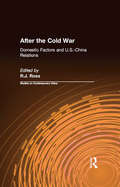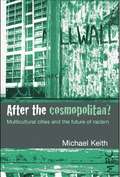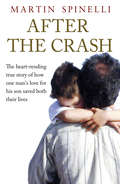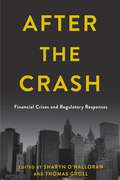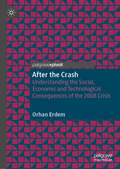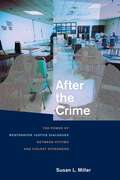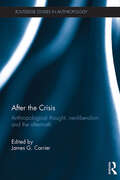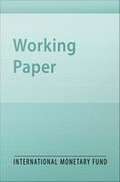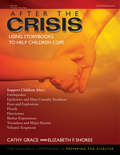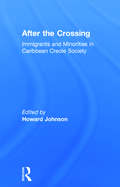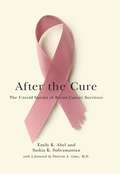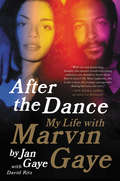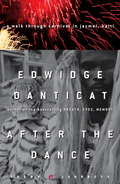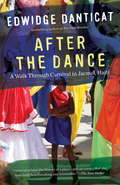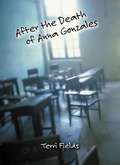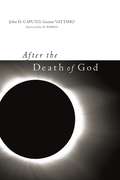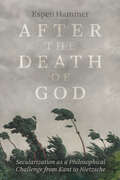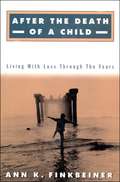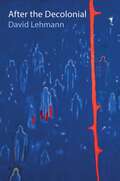- Table View
- List View
After the Cold War: Domestic Factors and U.S.-China Relations
by R.J. RossAs relations between the United States and China move into a period of intense activity and sensitivity, this timely book addresses the impact of domestic factors in both countries on their post-Cold War/post-Tiananmen relations. The contributors examine the issue from a number of distinct perspectives: the increased impact of domestic factors in both countries due to changing strategic circumstances; the politics of China policy in the United States, with emphasis on the role of interest groups vis-a-vis Congress, the media, and other domestic institutions; the importance of domestic factors in U.S.-China economic conflicts; the combined impact of domestic factors in both China and the United States on the most important conflict of interest in U.S.-China relations -- the Taiwan issue.
After the Cosmopolitan?: Multicultural Cities and the Future of Racism
by Michael KeithAfter the Cosmopolitan? argues that both racial divisions and intercultural dialogue can only be understood in the context of the urbanism through which they are realized. All the key debates in cultural theory and urban studies are covered in detail: the growth of cultural industries and the marketing of cities social exclusion and violence the nature of the ghetto the cross-disciplinary conceptualization of cultural hybridity the politics of third-way social policy. In considering the ways in which race is played out in the world's most eminent cities, Michael Keith shows that neither the utopian naiveté of some invocations of cosmopolitan democracy, nor the pessimism of multicultural hell can adequately make sense of the changing nature of contemporary metropolitan life. Authoritative and informative, this book will be of interest to advanced undergraduates, postgraduates and researchers of anthropology, cultural studies, geography, politics and sociology.
After the Coup: An Ethnographic Reframing of Guatemala 1954
by Timothy J. Smith Abigail E AdamsThis exceptional collection revisits the aftermath of the 1954 coup that ousted the democratically elected Guatemalan president Jacobo Arbenz. Contributors frame the impact of 1954 not only in terms of the liberal reforms and coffee revolutions of the nineteenth century, but also in terms of post-1954 U.S. foreign policy and the genocide of the 1970s and 1980s. This volume is of particular interest in the current era of the United States' re-emerging foreign policy based on preemptive strikes and a presumed clash of civilizations. Recent research and the release of newly declassified U.S. government documents underscore the importance of reading Guatemala's current history through the lens of 1954. Scholars and researchers who have worked in Guatemala from the 1940s to the present articulate how the coup fits into ethnographic representations of Guatemala. Highlighting the voices of individuals with whom they have lived and worked, the contributors also offer an unmatched understanding of how the events preceding and following the coup played out on the ground. Contributors are Abigail E. Adams, Richard N. Adams, David Carey Jr., Christa Little-Siebold, Judith M. Maxwell, Victor D. Montejo, June C. Nash, and Timothy J. Smith.
After the Crash
by Martin Spinelli'In the pit of my stomach, as I kissed my four-year-old son Lio and my darling wife Sasha goodbye, I knew something was up. By that evening, the police had told me about the crash.'Lio's bright and talented mother was killed that day, and he narrowly escaped the same fate. But instead of it being an ending for us, the crash was a beginning.'Lio's miraculous recovery from severe brain damage and a coma defied medical science. As I witnessed his astonishing journey - from intensive care bed to 10 Downing Street - and fought to pull him through horrific injuries and the loss of his mother, I found real purpose and meaning for the first time in my life.'After the Crash is much more than a moving personal story. It's a handbook for dealing with disaster, not just surviving it but mastering it and using it to transform your life for the better.
After the Crash: Financial Crises and Regulatory Responses
by Thomas O’Halloran Sharyn GrollThe 2008 crash was the worst financial crisis and the most severe economic downturn since the Great Depression. It triggered a complete overhaul of the global regulatory environment, ushering in a stream of new rules and laws to combat the perceived weakness of the financial system. While the global economy came back from the brink, the continuing effects of the crisis include increasing economic inequality and political polarization. <P><P>After the Crash is an innovative analysis of the crisis and its ongoing influence on the global regulatory, financial, and political landscape, with timely discussions of the key issues for our economic future. It brings together a range of experts and practitioners, including Joseph Stiglitz, a Nobel Prize winner; former congressman Barney Frank; former treasury secretary Jacob Lew; Paul Tucker, a former deputy governor of the Bank of England; and Steve Cutler, general counsel of JP Morgan Chase during the financial crisis. Each poses crucial questions: What were the origins of the crisis? How effective were international and domestic regulatory responses? Have we addressed the roots of the crisis through reform and regulation? Are our financial systems and the global economy better able to withstand another crash? After the Crash is vital reading as both a retrospective on the last crisis and an analysis of possible sources of the next one.
After the Crash: Understanding the Social, Economic and Technological Consequences of the 2008 Crisis
by Orhan ErdemThis book seeks to diagnose and analyze the social, economic and technological consequences of the 2008 financial crisis, which brought epochal changes to our lives. First and foremost, a paradigm shift arose in economic theories that fail to predict or explain the crisis. On the governmental side, we have been observing a natural parallel between authoritarianism and the way many democratic countries are being governed. Liberalism seems to have failed. Driven by the anger over the crisis and its heavy burden, a variety of technological innovations were birthed and gained momentum. Bitcoin was a manifesto to the monetary system; sharing economy was a rebellion to the consumerist lifestyle; and subscriptions were a threat to ownership. This books ties each of these events to the 2008 crisis and explains the connection.
After the Crime: The Power of Restorative Justice Dialogues between Victims and Violent Offenders
by Susan L. Miller2012 Winner of the Outstanding Book Award presented by the Academy of Criminal Justice Sciences Outstanding Academic Title from 2011 by Choice MagazineToo often, the criminal justice system silences victims, which leaves them frustrated, angry, and with many unanswered questions. Despite their rage and pain, many victims want the opportunity to confront their offenders and find resolution. After the Crime explores a victim-offender dialogue program that offers victims of severe violence an opportunity to meet face-to-face with their incarcerated offenders. Using rich in-depth interview data, the book follows the harrowing stories of crimes of stranger rape, domestic violence, marital rape, incest, child sexual abuse, murder, and drunk driving, ultimately moving beyond story-telling to provide an accessible scholarly analysis of restorative justice. Susan Miller argues that the program has significantly helped the victims who chose to face their offenders in very concrete, transformative ways. Likewise, the offenders have also experienced positive changes in their lives in terms of creating greater accountability and greater victim empathy. After the Crime explores their transformative experiences with restorative justice, vividly illustrating how one program has worked in conjunction with the criminal justice system in order to strengthen victim empowerment.
After the Crisis: Anthropological Thought, Neoliberalism and the Aftermath (Routledge Studies in Anthropology)
by James G. CarrierAfter the Crisis: Anthropological Thought, Neoliberalism and the Aftermath offers a thought-provoking examination of the state of contemporary anthropology, identifying key issues that have confronted the discipline in recent years and linking them to neoliberalism, and suggesting how we might do things differently in the future. The first part of the volume considers how anthropology has come to resemble, as a result of the rise of postmodern and poststructural approaches in the field, key elements of neoliberalism and neoclassical economics by rejecting the idea of system in favour of individuals. It also investigates the effect of the economic crisis on funding and support for higher education and addresses the sense that anthropology has ‘lost its way’, with uncertainty over the purpose and future of the discipline. The second part of the book explores how the discipline can overcome its difficulties and place itself on a firmer foundation, suggesting ways that we can productively combine the debates of the late twentieth century with a renewed sense that people live their lives not as individuals, but as enmeshed in webs of relationship and obligation.
After the Crisis: Assessing the Damage in Italy
by Silvia Sgherri Hanan MorsyFinancial report from the IMF
After the Crisis: Lower Consumption Growth but Narrower Global Imbalances?
by Franziska Ohnsorge Ashoka ModyWe estimate consumption dynamics in the G-7 economies, paying particular attention to the possibility of precautionary behavior in the face of uncertainty. We find that in the short run, continued income uncertainty will significantly dampen consumption growth. As such, consumption in the G-7 economies is unlikely to be the engine that revives global growth. Differences in the pace and timing of consumption moderation have implications for the evolution of global imbalances. With the U.S. experiencing a sharper rise in unemployment and, perhaps, more widespread loss of financial wealth than elsewhere in the G-7, the relative rise of the U.S. savings rate is helping narrow global imbalances. But with a likely earlier recovery in the U.S., this narrowing could be short-lived. Moreover, long-term differences- in economic and financial volatility and in demographic structures-have been an important source of the imbalances and could soon reassert their prominence.
After the Crisis: Using Storybooks to Help Children Cope
by Elizabeth Shores Cathy GraceWhen a crisis shakes a child's life, it is often up to teachers to recognize and identify signs that the child is suffering from continuing stress, and to help parents make appropriate decisions regarding next steps. Although most teachers cannot provide therapy to children under traumatic stress, they already have the tools they need to help children cope: storybooks.The literature-based activities in After the Crisis help children who have been through a trauma. With activities and exercises that can be used in conjunction with 50 children's books, teachers can use the discussion starters, writing activities, and art activities in After the Crisis to promote children's ability to cope and heal.After the Crisis addresses numerous crises that can affect a child: * Earthquakes * Epidemics and mass casualty incidents * Floods * Hurricanes * Tornadoes and major storms * Shelter experiences * Volcano eruptions * Death of a loved one After the Crisis is the companion book to Preparing for Disaster: What Every Early Childhood Director Needs to Know.
After the Crossing: Immigrants and Minorities in Caribbean Creole Society
by Howard JohnsonFirst published in 1990. Routledge is an imprint of Taylor & Francis, an informa company.
After the Cure: The Untold Stories of Breast Cancer Survivors
by Emily K. Abel Saskia K. Subramanian2009 Choice Outstanding Academic Title2009 Association of American University Presses Award for Jacket DesignThe stories of 70 women living in the aftermath of breast cancerChemo brain. Fatigue. Chronic pain. Insomnia. Depression. These are just a few of the ongoing, debilitating symptoms that plague some breast-cancer survivors long after their treatments have officially ended. While there are hundreds of books about breast cancer, ranging from practical medical advice to inspirational stories of survivors, what has been missing until now is testimony from the thousands of women who continue to struggle with persistent health problems.After the Cure is a compelling read filled with fascinating portraits of more than seventy women who are living with the aftermath of breast cancer. Emily K. Abel is one of these women. She and her colleague, Saskia K. Subramanian, whose mother died of cancer, interviewed more than seventy breast cancer survivors who have suffered from post-treatment symptoms. Having heard repeatedly that “the problems are all in your head,” many don't know where to turn for help. The doctors who now refuse to validate their symptoms are often the very ones they depended on to provide life-saving treatments. Sometimes family members who provided essential support through months of chemotherapy and radiation don't believe them. Their work lives, already disrupted by both cancer and its treatment, are further undermined by the lingering symptoms. And every symptom serves as a constant reminder of the trauma of diagnosis, the ordeal of treatment, and the specter of recurrence.Most narratives about surviving breast cancer end with the conclusion of chemotherapy and radiation, painting stereotypical portraits of triumphantly healthy survivors, women who not only survive but emerge better and stronger than before. Here, at last, survivors step out of the shadows and speak compellingly about their “real” stories, giving voice to the complicated, often painful realities of life after the cure. This book received funding from the Susan G. Komen Foundation.
After the Dance
by David Ritz Jan GayeA searing memoir of love, drugs, sex, and old-school R&B, from the former wife of the legendary soul icon Marvin GayeStuck in a foster home with an abusive caregiver, Janis Hunter found solace in her dreams of an encounter with Marvin Gaye--the soulful prince of Motown, with the seductive liquid voice, whose chart-topping, socially conscious album What's Going On had recently made him a superstar.They met in February 1973. Despite a seventeen-year age difference and Marvin's marriage to the sister of Berry Gordy, Motown's founder, the enchanted teenager and the emotionally volatile singer began a scorching relationship. One moment Jan was a high school student, the next she was Marvin's soulmate. Their romance navigated the hippie high life of the seventies and took the couple from one adventure to another.But the distractions and burdens of fame, the chaos of dysfunctional families, and the irresistible temptation of drugs complicated the love they shared. Marvin and Jan hurt each other, and their relationship descended into a dark place, but the attraction was too magnetic and the love was too strong to let go. Largely silent since Marvin's tragic death in 1984, Jan has at last opened up, sharing the moving, passionate story of one of music history's most fabled relationships. Unsparing in its honesty and insight, After the Dance reveals what it's like to be in love with an artistic genius, a man whose words and music have touched the world and made him a legend.
After the Dance
by Edwidge DanticatInAfter the Dance, one of Haiti’s most renowned daughters returns to her homeland, taking readers on a stunning, exquisitely rendered journey beyond the hedonistic surface of Carnival and into its deep heart. Edwidge Danticat had long been scared off from Carnival by a loved one, who spun tales of people dislocating hips from gyrating with too much abandon, losing their voices from singing too loudly, going deaf from the clamor of immense speakers, and being punched, stabbed, pummeled, or fondled by other lustful revelers. Now an adult, she resolves to return and exorcise her Carnival demons. She spends the week before Carnival in the area around Jacmel, exploring the rolling hills and lush forests and meeting the people who live and die in them. During her journeys she traces the heroic and tragic history of the island, from French colonists and Haitian revolutionaries to American invaders and home-grown dictators. Danticat also introduces us to many of the performers, artists, and organizers who re-create the myths and legends that bring the Carnival festivities to life. When Carnival arrives, we watch as she goes from observer to participant and finally loses herself in the overwhelming embrace of the crowd. Part travelogue, part memoir, this is a lyrical narrative of a writer rediscovering her country along with a part of herself. It’s also a wonderful introduction to Haiti’s southern coast and to the true beauty of Carnival.
After the Dance: A Walk Through Carnival in Jacmel, Haiti (Updated) (Vintage Departures)
by Edwidge DanticatIn After the Dance, one of Haiti's most renowned daughters returns to her homeland, taking readers on a stunning, exquisitely rendered journey beyond the hedonistic surface of Carnival and into its deep heart.Edwidge Danticat had long been scared off from Carnival by a loved one, who spun tales of people dislocating hips from gyrating with too much abandon, losing their voices from singing too loudly, going deaf from the clamor of immense speakers, and being punched, stabbed, pummeled, or fondled by other lustful revelers. Now an adult, she resolves to return and exorcise her Carnival demons. She spends the week before Carnival in the area around Jacmel, exploring the rolling hills and lush forests and meeting the people who live and die in them. During her journeys she traces the heroic and tragic history of the island, from French colonists and Haitian revolutionaries to American invaders and home-grown dictators. Danticat also introduces us to many of the performers, artists, and organizers who re-create the myths and legends that bring the Carnival festivities to life. When Carnival arrives, we watch as she goes from observer to participant and finally loses herself in the overwhelming embrace of the crowd.Part travelogue, part memoir, this is a lyrical narrative of a writer rediscovering her country along with a part of herself. It's also a wonderful introduction to Haiti's southern coast and to the true beauty of Carnival.
After the Darkest Hour: How Suffering Begins the Journey to Wisdom
by Kathleen A. BrehonyIn the tradition of When Bad Things Happen to Good People, a book that explains the transformative power of sufferingMost people understand that suffering and sorrow are inevitable parts of every life and that illness, death, or loss of a loved one are universal experiences, not retribution or a symptom of bad luck. But few of us comprehend the ways in which suffering can give rise to growth. In this sensitive and caring book, Kathleen Brehony describes the experiences of people who have endured life's trials and consequently found deeper spiritual and psychological meaning in their lives. Drawing on a rich selection of mythological and religious stories from many faiths, Berhony provides a historical and cultural context that enriches the meaning of these deeply personal tales. After the Darkest Hour explores the qualities--psychological, behavioral, and spiritual--of those who have turned periods of pain and suffering into opportunities for growth and renewal. The final chapters offer exercises that will help readers approach the difficult situations they face in a more conscious, enlightened way, as well as specific suggestions for creating personal healing rituals.
After the Death of Anna Gonzales
by Terri FieldsPoems written in the voices of forty-seven people, including students, teachers, and other school staff, record the aftermath of a high school student's suicide and the preoccupations of teen life.
After the Death of God (Insurrections: Critical Studies in Religion, Politics, and Culture)
by Gianni Vattimo John CaputoIt has long been assumed that the more modern we become, the less religious we will be. Yet a recent resurrection in faith has challenged the certainty of this belief. In these original essays and interviews, leading hermeneutical philosophers and postmodern theorists John D. Caputo and Gianni Vattimo engage with each other's past and present work on the subject and reflect on our transition from secularism to postsecularism. <P><P>As two of the figures who have contributed the most to the theoretical reflections on the contemporary philosophical turn to religion, Caputo and Vattimo explore the changes, distortions, and reforms that are a part of our postmodern faith and the forces shaping the religious imagination today. Incisively and imaginatively connecting their argument to issues ranging from terrorism to fanaticism and from politics to media and culture, these thinkers continue to reinvent the field of hermeneutic philosophy with wit, grace, and passion.
After the Death of God: Secularization as a Philosophical Challenge from Kant to Nietzsche
by Espen HammerA fresh history of nineteenth-century philosophy’s many ideas about secularization. The secularization thesis, which held that religious belief would gradually yield to rationality, has been thoroughly debunked. What, then, can we learn from philosophers for whom the death of God seemed so imminent? In this book, Espen Hammer offers a sweeping analysis of secularization in nineteenth-century German philosophy, arguing that the persistence of religion (rather than its absence) animated this tradition. Hammer shows that Kant, Hegel, Feuerbach, Marx, and Nietzsche, each in their own way, sought to preserve and transform religion’s ethical and communal aspirations for modern life. A renewed appreciation for this tradition’s generous thought, Hammer argues, can help us chart a path through needlessly destructive conflicts between secularists and fundamentalists today.
After the Death of Nature: Carolyn Merchant and the Future of Human-Nature Relations
by Kenneth Worthy Whitney A. Bauman Elizabeth AllisonCarolyn Merchant’s foundational 1980 book The Death of Nature: Women, Ecology, and the Scientific Revolution established her as a pioneering researcher of human-nature relations. Her subsequent groundbreaking writing in a dozen books and over one hundred peer-reviewed articles have only fortified her position as one of the most influential scholars of the environment. This book examines and builds upon her decades-long legacy of innovative environmental thought and her critical responses to modern mechanistic and patriarchal conceptions of nature and women as well as her systematic taxonomies of environmental thought and action. Seventeen scholars and activists assess, praise, criticize, and extend Merchant’s work to arrive at a better and more complete understanding of the human place in nature today and the potential for healthier and more just relations with nature and among people in the future. Their contributions offer personal observations of Merchant’s influence on the teaching, research, and careers of other environmentalists.
After the Death of a Child
by Ann K. FinkbeinerFor a parent, losing a child is the most devastating event that can occur. Most books on the subject focus on grieving and recovery, but as most parents agree, there is no recovery from such a loss. This book examines the continued love parents feel for their child and the many poignant and ingenious ways they devise to preserve the bond. Through detailed profiles of parents, Ann Finkbeiner shows how new activities and changed relationships with their spouse, friends, and other children can all help parents preserve a bond with the lost child. Based on extensive interviews and grief research, Finkbeiner explains how parents have changed five to twenty-five years after the deaths of their children. The first half of the book discusses the short- and long-term effects of the child's death on the parent's relationships with the outside world, that is, with their spouses, other children, friends, and relatives. The second half of the book details the effect on the parents' internal world: their continuing sense of guilt; their need to place the death in some larger context and their inability sometimes to consistently do so; their new set of priorities; the nature of their bond with the lost child and the subtle and creative ways they have of continuing that bond. Finkbeiner's central point is not so much how parents grieve for their children, but how they love them. Refusing to fall back on pop jargon about "recovery" or to offer easy solutions or standardized timelines, Finkbeiner's is a genuine and moving search to come to terms with loss. Her complex profiles of parents resonate with the honesty and authenticity of uncomfortable emotions expressed and, most importantly, shared with others experiencing a similar loss. Finally, each profile exemplifies the many heroic ways parents learn to live with their pain, and by so doing, honor the lives their children should have lived.
After the Death of a Child: Living with the Loss Through the Years
by Ann K. FinkbeinerFor a parent, losing a child is the most devastating event that can occur. Most books on the subject focus on grieving and recovery, but as most parents agree, there is no recovery from such a loss. This book examines the continued love parents feel for their child and the many poignant and ingenious ways they devise to preserve the bond. Through detailed profiles of parents, Ann Finkbeiner shows how new activities and changed relationships with their spouse, friends, and other children can all help parents preserve a bond with the lost child. Based on extensive interviews and grief research, Finkbeiner explains how parents have changed five to twenty-five years after the deaths of their children. The first half of the book discusses the short- and long-term effects of the child's death on the parent's relationships with the outside world, that is, with their spouses, other children, friends, and relatives. The second half of the book details the effect on the parents' internal world: their continuing sense of guilt; their need to place the death in some larger context and their inability sometimes to consistently do so; their new set of priorities; the nature of their bond with the lost child and the subtle and creative ways they have of continuing that bond. Finkbeiner's central point is not so much how parents grieve for their children, but how they love them. Refusing to fall back on pop jargon about "recovery" or to offer easy solutions or standardized timelines, Finkbeiner's is a genuine and moving search to come to terms with loss. Her complex profiles of parents resonate with the honesty and authenticity of uncomfortable emotions expressed and, most importantly, shared with others experiencing a similar loss. Finally, each profile exemplifies the many heroic ways parents learn to live with their pain, and by so doing, honor the lives their children should have lived.
After the Decolonial: Ethnicity, Gender and Social Justice in Latin America
by David LehmannAfter the Decolonial examines the sources of Latin American decolonial thought, its reading of precursors like Fanon and Levinas and its historical interpretations. In extended treatments of the anthropology of ethnicity, law and religion and of the region’s modern culture, Lehmann sets out the bases of a more grounded interpretation, drawing inspiration from Mexico, Brazil, Bolivia and Chile, and from a lifelong engagement with issues of development, religion and race. The decolonial places race at the centre of its interpretation of injustice and, together with the multiple other exclusions dividing Latin American societies, traces it to European colonialism. But it has not fully absorbed the uniquely unsettling nature of Latin American race relations, which perpetuate prejudice and inequality, yet are marked by métissage, pervasive borrowing and mimesis. Moreover, it has not integrated its own disruptive feminist branch, and it has taken little interest in either the interwoven history of indigenous religion and hegemonic Catholicism or the evangelical tsunami which has upended so many assumptions about the region’s culture. The book concludes that in Latin America, where inequality and violence are more severe than anywhere else, and where COVID-19 has revealed the deplorable state of the institutions charged with ensuring the basic requirements of life, the time has come to instate a universalist concept of social justice, encompassing a comprehensive approach to race, gender, class and human rights.
After the Deluge: India's Reconstruction Following the 2004 Tsunami
by Human Rights WatchIn a 47-page report released today, After the Deluge: India's Reconstruction Following the 2004 Tsunami, Human Rights Watch examines the Indian government's response to the tsunami and documents several systemic and potentially enduring failures. Human Rights Watch applauded the Indian government's overall response to the tsunami, but found that government recovery efforts did not adequately take into account the needs of different vulnerable segments of the affected population, particularly women, children, the disabled, Dalits (so-called untouchables) and tribal groups. In India, particularly in the weeks right after the tsunami, Human Rights Watch documented discrimination against Dalits by other victims of the tsunami, who belonged to a higher caste. In many instances, the Indian government failed to enforce its existing legislation and policy to protect vulnerable groups. Human Rights Watch urged the Indian government to undertake effective training and education-both for officials and the affected communities-part of its disaster management strategy.
